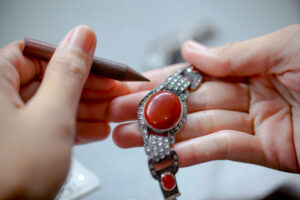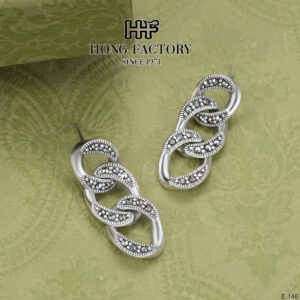How to Spot High-Quality Jewelry Pieces
Investing in high-quality jewelry is about more than just aesthetics—it’s about durability, craftsmanship, and value. Whether purchasing fine jewelry for a special occasion or adding to your collection, understanding how to assess quality is essential. This guide will walk you through key factors to consider when evaluating jewelry, from materials and craftsmanship to authentication and ethical sourcing.
How to Spot High-Quality Jewelry Pieces

1. Understanding Precious Metals
- Gold Purity Levels: Gold jewelry comes in different karat ratings (10K, 14K, 18K, and 24K), with higher karats containing more gold and being softer. Higher karat gold (22K-24K) is prized for its purity but is less durable, making 14K-18K ideal for everyday wear.
- Sterling Silver vs. Silver-Plated: Genuine sterling silver is marked “925” and is more durable than silver-plated jewelry, which may tarnish or wear off over time. Oxidized sterling silver is also gaining popularity for its vintage appeal.
- Platinum’s Durability: Platinum is more durable and hypoallergenic compared to white gold, making it a preferred choice for engagement rings and heirloom pieces. Platinum’s natural whiteness does not fade over time, unlike rhodium-plated white gold.
- Hallmarks and Stamps: Look for markings like “750” for 18K gold, “950” for platinum, or “925” for sterling silver to verify authenticity. Well-known jewelry brands often include a hallmark to indicate the maker and ensure authenticity.
2. Evaluating Gemstone Quality
- The 4 Cs of Diamonds: Learn about Cut, Color, Clarity, and Carat Weight, which determine a diamond’s value. A well-cut diamond maximizes light return, making it appear more brilliant even with a lower carat weight.
- Certified Gemstones: Always look for stones certified by GIA (Gemological Institute of America) or AGS (American Gem Society) to ensure accurate grading.
- Natural vs. Lab-Grown Stones: While lab-grown diamonds and gemstones are chemically identical to natural ones, they often come at a lower price. Lab-grown diamonds are also a more sustainable and ethical choice.
- Enhancements and Treatments: Some gemstones undergo heat treatments, irradiation, or clarity enhancements—ask sellers about any modifications to understand durability and value.
- Origin Matters: Certain origins, like Burmese rubies or Colombian emeralds, are highly valued due to their rarity and exceptional color quality.
3. Examining Craftsmanship and Construction
- Prong and Setting Quality: Secure prongs ensure gemstones are held firmly in place, preventing them from loosening. Poorly set stones may lead to loss over time, especially for daily wear pieces.
- Smooth Finishing: High-quality jewelry should have polished, smooth edges with no visible solder marks, rough surfaces, or sharp areas.
- Clasps and Closures: Test the durability of clasps on necklaces and bracelets—weak clasps can lead to loss of jewelry. Look for lobster clasps or box clasps for added security.
- Weight and Balance: Fine jewelry should have a substantial feel without being overly heavy or flimsy. Gold-plated or hollow jewelry may feel light, indicating lower quality.
- Handmade vs. Machine-Made Jewelry: Handcrafted jewelry often exhibits intricate detailing and slight variations, showcasing superior craftsmanship.
4. Authenticity Verification and Certification
- Request Certification Reports: Diamonds, pearls, and other precious stones should come with certificates verifying their authenticity and quality.
- Check for Serial Numbers: Luxury jewelry brands engrave serial numbers to ensure traceability and prevent counterfeiting.
- Ask for an Appraisal: Reputable jewelers provide appraisal documents for insurance and resale purposes. This ensures proper valuation and protection for high-value pieces.
- Magnet Test for Gold: Pure gold is non-magnetic—if a gold item is attracted to a magnet, it likely contains other metals or is plated.
5. Ethical and Sustainable Jewelry Practices
- Conflict-Free Diamonds: Look for diamonds certified by the Kimberley Process to ensure ethical sourcing. Many brands are now offering blockchain tracking for full transparency.
- Fair Trade and Recycled Metals: Many brands now use recycled gold and ethically mined gemstones to reduce environmental impact.
- Sustainable Jewelry Brands: Research companies that prioritize ethical labor practices and sustainable materials. Brands like Chopard, Pandora, and Tiffany & Co. are leading the way in sustainable jewelry.
- Eco-Friendly Packaging: High-quality jewelry brands often use sustainable, biodegradable, or reusable packaging to minimize environmental impact.
6. Avoiding Counterfeit and Low-Quality Jewelry
- Be Wary of Too-Good-to-Be-True Prices: If a deal seems too good, it may indicate fake or low-quality materials.
- Check Seller Reputation: Always buy from reputable jewelers with strong customer reviews and verifiable history.
- Inspect Metal Plating: Gold-plated jewelry wears off over time—if buying plated pieces, ensure they have a thick and durable coating. Gold vermeil (gold over sterling silver) is a better alternative to cheaply plated jewelry.
- UV Light Test for Gemstones: Some gemstones, such as rubies and emeralds, have unique fluorescence under UV light, which can help identify authenticity.
7. The Future of High-Quality Jewelry
- Blockchain Authentication: Digital records are being used to trace the origin and authenticity of fine jewelry, providing greater transparency for buyers.
- Lab-Grown Diamonds and Eco-Friendly Gems: More consumers are turning to sustainable alternatives to traditional mined stones, making lab-grown diamonds an increasingly popular choice.
- AI-Powered Jewelry Shopping: Advanced technology helps buyers make informed choices based on real-time market data and personal preferences.
- 3D-Printed Custom Jewelry: Personalized jewelry is on the rise, with 3D printing allowing customers to design their own unique pieces.
- Smart Jewelry: Wearable tech is integrating into fine jewelry, with pieces like rings and bracelets featuring NFC chips, health tracking, or digital authentication features.
- Heirloom Jewelry Reinvention: More people are resetting family gemstones into modern designs to preserve sentimental value while keeping up with contemporary trends.
Spotting high-quality jewelry requires attention to detail, from verifying materials to assessing craftsmanship. By researching hallmarks, certifications, and ethical sourcing, you can ensure your jewelry investment is both valuable and lasting. Whether buying a diamond ring, gold necklace, or gemstone earrings, these tips will help you make informed and confident purchases. With the jewelry industry evolving toward sustainability and technology, future buyers will have even more tools to ensure authenticity, quality, and ethical responsibility in their purchases.






